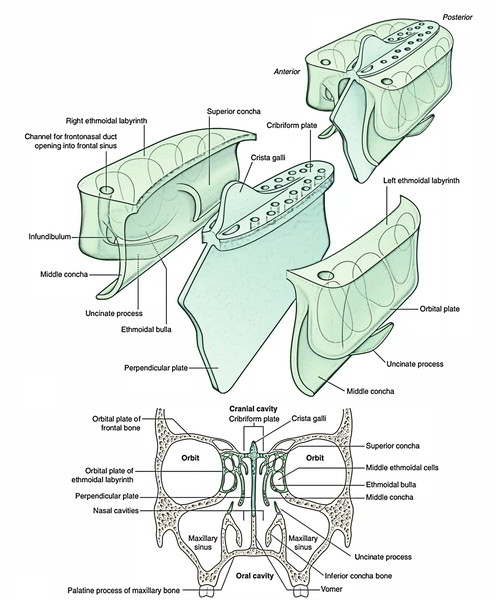The ethmoid bone is situated between 2 orbital cavities and is an unpaired delicate bone. It possesses a perforated (sieve-like) plate referred to as cribriform plate that is why it is called ethmoid bone (Gr. ethmoid = sieve-like).
Parts
The ethmoid bone is made from the following parts:
- Cribriform plate.
- Crista galli.
- Perpendicular plate.
- 2 mazes.
Cribriform Plate
It separates the nasal cavities from the anterior cranial fossa and fills the ethmoidal notch between the 2 orbital plates of the frontal bone. It’s a number of small pores in it which carry the filaments of olfactory nerve from the olfactory epithelium of the nasal cavity to the olfactory bulb of the brain.
Crista Galli
It’s a triangular median crest on the upper surface of the cribriform plate. It resembles the crest on the head of Gallus domesticus (cock’s comb), the reddish development of flesh on the top of the head of a cock and supplies connection to the anterior end of the falx cerebri.
Perpendicular Plate
It’s a quadrilateral plate which projects downwards from the inferior surface of cribriform plate. It creates the upper part of the nasal septum.
Inner ears
The inner ears are the cuboidal bony cartons full of air cells. The air cells, according to their location, are split into 3 groups: anterior, middle and posterior. The lateral surfaces of the inner ear forms the medial wall of the orbit and medial surface creates the lateral wall of the nasal cavity. Both shelf-like projections from the medial surface are referred to as superior and middle conchae (remember: inferior concha is an independent bone).
Clinical Significance
In case of head injury, the blood stained discharge of CSF from nose (CSF rhinorrhea) suggests fracture of cribriform plate of the ethmoid in the anterior cranial fossa. It might result into anosmia (loss of smell) because of damage of olfactory nerves.


 (48 votes, average: 4.65 out of 5)
(48 votes, average: 4.65 out of 5)